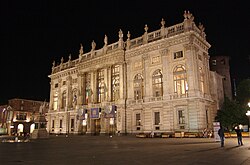History
The museum was founded in 1934, as the heir of the Pinacoteca Regia and the Galleria Reale, which had been established in Palazzo Madama by King Charles Albert of Savoy in 1832.
A Civic Museum had been founded in 1860 in the wake of the unification of Italy although, three years later, the collections were moved to another location in Turin, in Via Gaudenzio Ferrari. These were increased gradually with acquisitions from private collectors, from closed residences of the House of Savoy, or from donations by the same family.
In 1898 the collections of "ancient art" were separated from those of "modern art". The former were moved to the current location in 1934 by the director Vittorio Viale.
The collection of Asian art, including rare artifacts from Gandhara uncovered in the excavations by IsMEO at the Butkara Stupa in Pakistan, was transferred to Turin's Museum of Oriental Art in 2008.
Description
The museum includes a total of 35 rooms on four floors. The underground floor is dedicated to medieval works, the first floor to Gothic and Renaissance painting, and the second floor to Baroque works, while the uppermost floor deals with decorations.
Aside from paintings and sculptures, works exhibited also include illuminated manuscripts (such as the Turin–Milan Hours), ceramics, porcelains, maiolica and ivories (mostly of oriental origin), and gold and silver works, as well as a furniture and cloths.
The 15th-century Torre dei Tesori ('Tower of the Treasures') is home to several of the museum most known works: Antonello da Messina's Trivulzio Portrait , the Turin–Milan Hours, and several objects from Charles Emmanuel I's cabinet. Other works include a series of sculptures of the Dead Christ, paintings by Macrino d'Alba, Giacomo Jaquerio, Giovanni Martino Spanzotti, Defendente Ferrari, Antonio Vivarini, Giulio Campi, Gaudenzio Ferrari, Gandolfino da Roreto, Gerolamo Giovenone, Francesco Hayez, sculptors' and goldsmiths' works from the 8th to the 13th centuries, and Piedmontese coats of arms.
The Camera delle Guardie ('Guards Chambers') houses Baroque paintings by artists such as Orazio Gentileschi (Assumption and St. Jerome), Giovanni Battista Crespi, Giulio Cesare Procaccini and Francesco Cairo.

Antonello da Messina, properly Antonello di Giovanni di Antonio, but also called Antonello degli Antoni and Anglicized as Anthony of Messina, was an Italian painter from Messina, active during the Early Italian Renaissance. His work shows strong influences from Early Netherlandish painting, although there is no documentary evidence that he ever travelled beyond Italy. Giorgio Vasari credited him with the introduction of oil painting into Italy, although this is now disputed. Unusually for a southern Italian artist of the Renaissance, his work proved influential on painters in northern Italy, especially in Venice.
Portrait of a Man is the conventional title of several male portraits by the Italian Renaissance artist Antonello da Messina.

Palazzo Madama e Casaforte degli Acaja is a palace in Turin, Piedmont. It was the first Senate of the Kingdom of Italy, and takes its traditional name from the embellishments it received under two queens (madama) of the House of Savoy.

Antonio d'Enrico, called Tanzio da Varallo, or simply il Tanzio was an Italian painter of the late-Mannerist or early Baroque period.
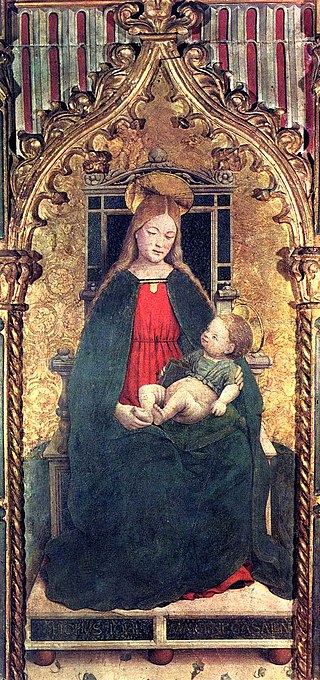
Giovanni Martino Spanzotti was an Italian painter active in Piedmont, Lombardy and northern Italy.

The Galleria Sabauda is an art collection in the Italian city of Turin, which contains the royal art collections amassed by the House of Savoy over the centuries. It is located on Via XX Settembre, 86.
Ecce Homo is the title of a series of paintings by the Italian Renaissance master Antonello da Messina. They date from 1470 to 1475.

Maestro della Cappella di Santa Margherita a Crea, or more simply Maestro di Crea, is the name given to the anonymous Italian painter who was engaged by Guglielmo VIII Paleologo, Marquis of Montferrat, to decorate the chapel of Santa Margherita in the Santuario della Madonna di Crea near Serralunga di Crea. The work was performed during the years 1474–1479. The sanctuary stands on the highest hill of the Basso Monferrato; later it would form the focal pont of the Sacro Monte di Crea.

The Museo Nazionale della Magna Grecia, Museo Archeologico Nazionale di Reggio Calabria or Palazzo Piacentini is a museum in Reggio Calabria, southern Italy, housing an archaeological collection from sites in Magna Graecia.

The Museum of Oriental Art is a museum located in a 17th-century palazzo in the city of Turin, Italy.

Pelagio Palagi was an Italian painter, sculptor and interior decorator.
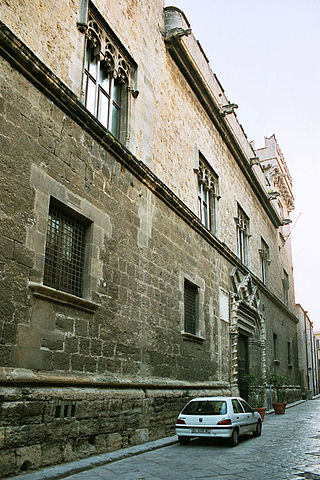
Palazzo Abatellis is a palazzo in Palermo, Sicily, southern Italy, located in the Kalsa quarter. It is home to the Galleria Regionale della Sicilia, the Gallery of Art for the Sicilian region.
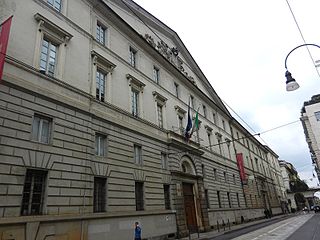
The Accademia Albertina di Belle Arti is an institution of higher education in Turin, Italy

The Palazzo Spinola di Pellicceria, also known as Palazzo Francesco Grimaldi, is a palace located in piazza di Pellicceria in the historical center of Genoa, Northwestern Italy. The palace was one of the 163 Palazzi dei Rolli of Genoa, the selected private residences where the notable guests of the Republic of Genoa were hosted during State visits. On 13 luglio del 2006 it was added to the list of 42 palaces which now form the UNESCO World Heritage Site Genoa: Le Strade Nuove and the system of the Palazzi dei Rolli. It is currently owned by the Ministry of Cultural Heritage and Activities and Tourism and houses the National Gallery of Art in Palazzo Spinola.

The Museo Interdisciplinare Regionale (MuMe). or Regional Museum of Messina, is an art museum located on the northern coast of the city of Messina, Sicily, Italy.
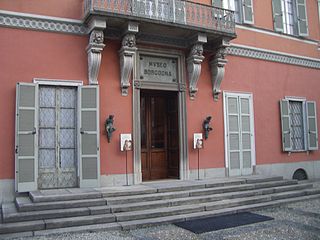
The Francesco Borgogna Museum, located on Via Francesco Borgogna near the town center of Vercelli in the region of Piedmont, displays a collection of paintings, frescoes, sculpture, tapestries, and other artifacts. The works originate from the 14th to the 20th century.

The Turin Civic Gallery of Modern and Contemporary Art is an art gallery in Turin, Italy, founded in 1891-1895 and located in 31 via Magenta. With the MAO, Palazzo Madama e Casaforte degli Acaja, the Borgo and the Rocca medioevali, it forms part of the Fondazione Torino Musei. The lower rooms house important reviews and a large collection of video art.

The Interdisciplinary Regional Museum of Messina is a museum of painting, sculpture and archaeology in the city of Messina. Until 2017 it was housed in the former Barbera-Mellinghoff silk-mill, a late 19th century building chosen for it after the 1908 Messina earthquake. Since 2017 it has been housed in a nearby complex designed in the 1970s.
Noemi Gabrielli was an Italian art historian, superintendent, and a museologist.
